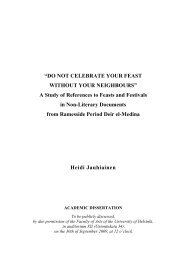BIA
bia51
bia51
You also want an ePaper? Increase the reach of your titles
YUMPU automatically turns print PDFs into web optimized ePapers that Google loves.
JUIN 2015<br />
Mardi 23 juin 2015<br />
Beginning in August, visitors of<br />
Tutankhamun’s galleries at the Egyptian<br />
Museum in Tahrîr will not be able to admire<br />
the king’s distinguished gold funerary mask<br />
which will leave its original display for intensive<br />
restoration to repair the improper restoration<br />
carried out recently.<br />
Minister of Antiquities Mamdûh al-Damâtî<br />
told Ahram Online that Tutankhamun’s gold<br />
funerary mask will go for restoration in August<br />
after the completion of the scientific studies<br />
carried out to discover the material used in its<br />
restoration and how to remove them without<br />
causing harm.<br />
“A month ago I assigned a scientific<br />
committee, led by me, to carry out a<br />
comprehensive analytic study on the mask<br />
since its discovery in 1922 in Tutankhamun’s<br />
tomb, as well as the restoration work carried<br />
out on it until now,” al-Damâtî said. al-Damâtî<br />
said that German restorer Christian ECKMANN<br />
assisted him in such studies because he is an<br />
expert in metal restoration.<br />
The committee includes the head of the<br />
German Archaeological Institute, Târiq Tawfîq,<br />
the head of the metal restoration section at<br />
the Egyptian Museum in Tahrîr Square, and a<br />
German CT-scan expert. The ministry has<br />
bought new CT scanning equipment to<br />
complete the study.<br />
After the completion of the study, ECKMANN<br />
will travel to Germany with the results, where<br />
he will create a gypsum replica of the mask<br />
using the proper materials, according to al-<br />
Damâtî. In August, he will then return to Cairo<br />
where an international conference is to be held<br />
to explain to the public and scholars the<br />
method selected to restore the beard through<br />
state-of-the-art technology. Then, the<br />
restoration itself is to start and all the work<br />
will be documented.<br />
In January 2015, it was reported that the<br />
blue and gold beard of the mask was broken<br />
during a cleaning process at the Egyptian<br />
Museum and that conservators hurriedly glued<br />
the beard back on with epoxy resin, damaging<br />
the artefact. The ministry of antiquities held a<br />
press conference where experts asserted that<br />
the mask is safe and that the botched<br />
restoration carried out in August 2014 is<br />
reversible. (Nevine El-Aref, “Restoration of<br />
Tutankhamun’s funerary mask to start in<br />
August”, Ahram Online, June 23, 2015. Voir<br />
également Muhammad ‘Abd al-Mu‘tî, « Retrait<br />
du masque de Toutankhamon pour<br />
restauration », al-Ahrâm, 17 juin).<br />
- -<br />
Jeudi 25 juin 2015<br />
The Ayyubid walls stretch for 1.5 km in the<br />
Bâb al-Wazîr area, just below al-Azhar Park, on<br />
what was once the rubbish tip of mediaeval<br />
Cairo. The walls were constructed in the 12 th<br />
century by Sultan Salâh al-Dîn al-Ayyûbî<br />
(Saladin) as part of his plans to connect the<br />
Fatimid city of al-Qâhira (Cairo) with the<br />
Citadel and its aqueduct.<br />
These walls, with their gates, towers, interior<br />
chambers and galleries, were one of the most<br />
important archaeological discoveries of the late<br />
1990s, as was the Qubat al-Amîr Tarâbây al-<br />
Sharîf, a dome structure built by the<br />
commander of the Mamluke soldiers during the<br />
reign of sultan Qunsuwwa al-Ghûrî located next<br />
to the walls.<br />
<strong>BIA</strong> LI — Janvier/Juin 2015 159



